Chrysanthemum annual in the garden: from planting to leaving
Chrysanthemums - herbaceous plants, can be annual and perennial. They belong to the Astrov family. Bright flowers of various shapes and colors look equally great both in cut and on a flower bed. Gardeners are well aware of the perennial varieties that adorn the site in autumn. However, annual chrysanthemums also have their advantages in planting and caring, which also deserve the attention of flower lovers.
Content:
- Review of the best species and varieties
- Reproduction and planting
- Care Tips
- Diseases and pests
- Application in landscape design
Review of the best species and varieties
Annual chrysanthemums go through a full life cycle (from seed to seed) in one growing season. This is convenient, since you do not have to worry about how the plant will survive the winter, make complex shelters or remove the underground part of the flower for storage.
There are several types of annual chrysanthemums, of which the following are more often grown in culture:
- Carinated or scaphoid (Ch. Carinatum). The plant is 20 to 70 cm high, the stem is erect. Basket-shaped inflorescences can be either simple or terry. The diameter of the flower is 5-7 cm. The colors are varied, often not monochromatic, but a combination of white, red, orange or yellow. On sale there are seeds of different colors in mixtures. Varieties: Cockard, Dunetti, Stern, Veselaya mix, Flamen Spire.
- Sowing (Ch. Segetum). It grows up to 50-80 cm. It has an erect stem that can branch. Flowers 3-7 cm in size, can be white or yellow, monochromatic. This type of chrysanthemum looks like an ordinary field chamomile. It can grow like a weed in the fields. Varieties: Gloria, Eldorado, Zebra, German flag, Helios, Star of the East. Provides rich self-seeding.
- Crowned (Ch. Coronarium). Reaches a height of 70 cm. Fleshy, branched stems. This species has very decorative dissected leaves. The inflorescence is solitary, up to 7 cm in diameter, it can be white or yellow. Popular varieties: Nivea, Orion, Tetra Komet, Primrose Gem, Cecilia, Zolotistaya.
- Odorless (Ch. Inodorum). Fast-growing bush up to 20 cm tall. The size of the inflorescences is 5-7 cm. Cultivar: Wedding dress with snow-white double flowers and feathery foliage.
- Prominent or turned (Ch. Spectabile). A tall bush, reaches a height of 120 cm and 70 cm in transverse diameter. Inflorescences up to 11 cm in diameter. Varieties: Annette, Cecilia.
All these types of annual chrysanthemums are distinguished by long flowering from June to September and even October (depending on the region of cultivation). Some species chrysanthemums (for example, maiden, daisy or marsh), although they are perennials, in our climate they are grown as annuals. This means that the same growing rules apply to them as to the above species.
Reproduction and planting
Annual chrysanthemums are propagated seeds, which are sown in two ways:
- in March - for seedlings
- in May - directly into the open ground (sowing and crowned ones can be sown in April)
Features of growing seedlings:
- For seedlings, seeds are sown to a depth of 1 cm in peat tablets, separate containers or common boxes in moist soil. The land is taken loose, air-permeable, with the addition of sand and peat.
- So that the seeds do not go into the depths, the first days the crops are not watered, but sprayed. In the southern regions, it is possible to sow seeds before winter.
- Before germination (after 5-15 days), the container is covered with foil or glass to create greenhouse conditions.
- Regular airing is imperative, otherwise mold may develop. With the emergence of seedlings, the shelter is removed.
- Chrysanthemum is a plant of a temperate climate, high temperatures can harm it.
- Two weeks after germination, young plants dive in separate pots and sprayed with growth stimulants for better survival (Epin, Zircon).
- A week after such a transplant, they can be fed with a universal flower fertilizer.
- Optimal conditions for growing seedlings: air temperature 15-18 ° C and good lighting.
Grown plants are planted in the ground when the danger of recurrent frosts has passed. When planting seedlings in a permanent place, the plant is deepened into the ground so that the cotyledon leaves are 1-2 cm below ground level. This method of planting will stimulate the formation of a lush bush.
Sowing immediately to a permanent place has a number of advantages: young flowers immediately adapt to the external environment, there is no danger of damaging the delicate roots during transplantation.
However, in this case, flowering will come a few weeks later than with the seedling method. On average, annual chrysanthemums bloom 8-10 weeks after sowing.
In open ground, seeds are sown in different ways:
- in the holes at a distance of 30-40 cm, 2-3 seeds are placed in one hole
- into grooves
Then the seeds are sprinkled with earth or peat with a layer of 2-3 cm and watered abundantly. To speed up germination, you can cover the bed with foil or non-woven fabric, leaving openings for air to enter. After the appearance of two or four true leaves, the seedlings must be thinned out: one sprout is left in each hole or for every 30-40 cm of the groove.
After 10 days, you can feed young chrysanthemums for the first time with complex fertilizer. The distance between the specimens of the crowned chrysanthemum is left up to 60 cm.
Care Tips
Annual chrysanthemums are unpretentious plants. A very useful quality for gardeners of these flowers is cold resistance, the ability to withstand return frosts up to 0 ° C.
When choosing a place for landing, the following factors are guided:
- maximum illumination with shelter at noon
- shelter from drafts
- good aeration of the soil without stagnant water
Annual chrysanthemums do not require rich soil, preferring light, moderately fertile ones. The attitude to the content of lime differs by type: for keeled chrysanthemum, its presence in the soil is useful, and sowing chrysanthemum, on the contrary, requires soil that is poor in lime.
The site where it is planned to place the chrysanthemums is prepared in the fall.
They dig it up, bring it in mineral fertilizers: superphosphate 50 g / m2, potassium sulfate 20-30 g / m2. Depending on the needs of the selected type of flower, lime is added to the soil. Chrysanthemums grow better where manure was brought in 2-3 years before planting.
Flower care is simple. Watering is required only in hot weather. So that the earth does not dry out, it is useful to mulch the soil around the chrysanthemum. This will reduce weeds and make maintenance easier. Fertilizers are applied 3-4 times per season, preferably in liquid form (20-30 g per 10 l of water).
In the first half of summer, until the plant has gained strength, you need to remove the weeds and gently loosen the soil next to the flower. For prolonged flowering, wilted buds are regularly cut off. In order for chrysanthemums to bush well, their tops are pinched. High varieties are tied up so that they do not lose their decorative effect from the effects of rain and wind.
Diseases and pests
Of the diseases, chrysanthemum can be affected by gray rot and powdery mildew... Common causes of fungal diseases are high soil moisture, low temperatures, and excess nitrogen fertilizers.
An outward sign of powdery mildew is a whitish coating that covers the entire plant. Gray rot is manifested by brown spots, on which plaque gradually forms and a focus of decay develops.To combat fungal diseases, a 1% solution is used Bordeaux mixture (spraying) or other copper preparations.
Of the pests, annual chrysanthemums attack:
- aphid
- thrips
- meadow bug
Aphids can be called the main pest of chrysanthemums. It depletes the plant by sucking nutrients from the leaves. With a small lesion, aphids are collected by hand, washed off with water or cut off along with a part of the plant. If there are many pests, chemical agents are used: Aktellik, Aktara, Fitoverm (use according to the instructions).
The meadow bug, like the aphid, sucks the juice from the plant. From this, white spots appear on the leaves. Over time, the leaves turn brown and dry, the inflorescences are deformed. Control measures are the same as for the defeat of aphids. As a folk remedy, spraying with a solution of baby shampoo is used. The external manifestation of the activity of thrips will be white and yellowish spots on the leaves of the flower. The fight is carried out with special drugs, for example, Aktellik.
Application in landscape design
This unpretentious long-flowering annual can become a real decoration of the site. It will look good both in monogroups and as part of mixborder... Especially beautiful are the beds of chrysanthemum keeled of different colors. Low-growing varieties are suitable for creating ridges and borders, for container gardening.
In combination with calendula, cosmos, snapdragons, marigolds, bells annual chrysanthemums will create a mood in a natural or rustic garden. There is also a place for chrysanthemums in the Asian garden, because in these countries it is especially beloved. Low odorless chrysanthemum looks good with petunia, cineraria and salvia... True lovers of this flower can come up with a garden project entirely consisting of annual and perennial chrysanthemums.
In addition to growing in flower beds, keeled and odorless chrysanthemums are used for cutting, since in bouquets they retain their decorative effect for a long time.
It is interesting to use the crowned chrysanthemum: in Asian countries, its leaves, young shoots and inflorescences are eaten. The species is valued for its rich content of vitamins B, C, PP, macro- and microelements. Chrysanthemum tastes like celery... Young leaves and petals are eaten raw in salads, the harder parts are stewed, boiled or fried, and then used as a side dish.
Thus, the annual chrysanthemum has a number of advantages: it can be grown without seedlings, it does not need to be covered for the winter. While perennial chrysanthemums only bloom in the fall, you will enjoy the vibrant annuals in July.
More information can be found in the video:




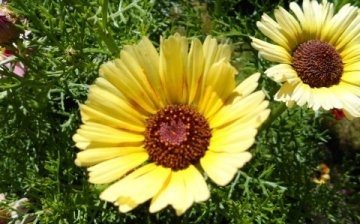
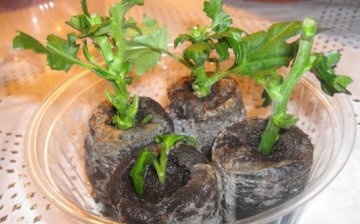
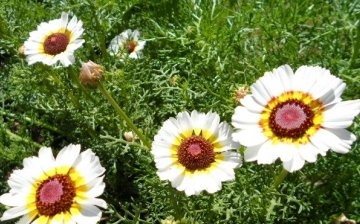
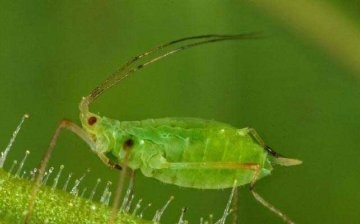
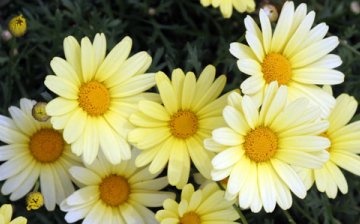






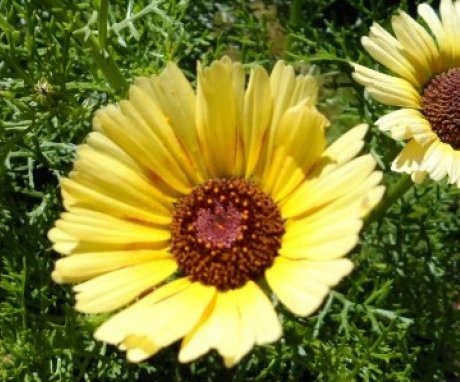
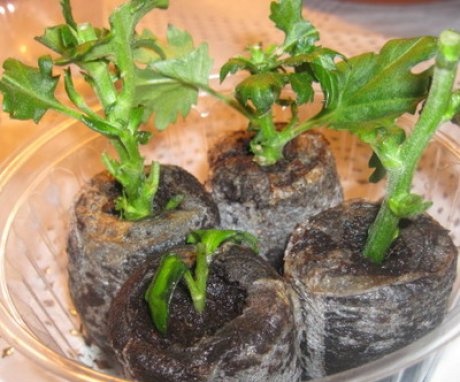
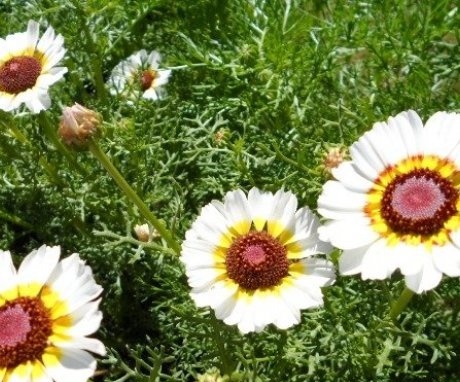

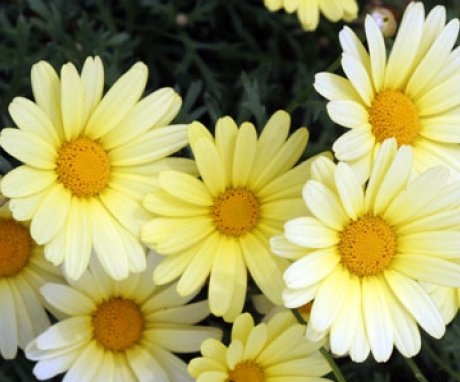
We always plant chrysanthemums in open ground, but not in May, but in April, while the ground is still wet. There are frosts in our region, but chrysanthemums always withstand them. We have chrysanthemums in the flowerbed every year, we like their large, beautiful flowers.
Mom has a lot of flowers at her summer cottage. She plants annuals directly in the ground with seeds in May. And chrysanthemum blooms in July. This year, the trouble, in general, either the drought affected, or the soil without fertilizers, but one tops began to grow, and the flower is not visible.